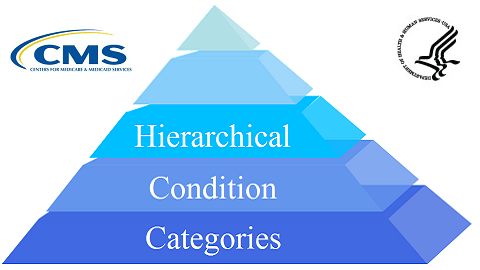Written by Joanne Byron, BS, LPN, CCA, CHA, CHCO, CHBS, CHCM, CIFHA, CMDP, OHCC, ICDCT-CM/PCS
Does your compliance program include auditing and monitoring documentation and coding related to risk adjustments and your value-based care reimbursement? Regulatory agencies and payers use hierarchical condition categories (HCCs) to calculate patient risk; the higher the risk score for a population, the higher the benchmark will be for expenditures, which can affect shared savings in value-based payment arrangements. This short article provides a basic overview of this complex topic.
Medicare & the OIG are performing Risk Adjustment audits, are you?
Detecting and internal correction of coding errors should be a major part of your overall compliance program. As always, correct coding must be supported by clinical documentation in the patient’s medical record.
Value-based care (VBC) is a healthcare delivery model where healthcare providers are paid based on patient health outcomes instead of based on the volume of patients seen and services delivered. Value-based care ties the amount health care providers earn for their services to the results they deliver for their patients, such as the quality, equity, and cost of care.

Risk adjustment and Hierarchical Condition Category (HCC) coding is a risk adjustment model that groups chronic medical conditions into categories based on cost patterns and clinical complexity. This was originally mandated by the Centers for Medicare & Medicaid Services (CMS) back in 1997 and implemented in 2004.
HCC coding relies on ICD-10-CM coding to assign risk scores to patients. The Office of Inspector General (OIG) and CMS both conduct targeted audits and reviews.
CMS uses HCCs to calculate payments to healthcare organizations for patients insured by Medicare Advantage, Accountable Care Organizations, and some Affordable Care Act plans. HCCs are based on ICD-10-CM coding, which assigns risk scores to patients. Insurance companies use these scores, along with demographic factors, to calculate a patient's risk adjustment factor (RAF) score.

Patients with high HCCs are expected to require more intensive medical treatment versus those enrollees who have low HCCs. Based on the HCC system, providers need to document all health conditions to the appropriate specificity level for CMS to ascertain the patients’ true health status which impacts the risk adjustment payment.
How can your organization improve accuracy of HCC documentation?
This is a complex topic. Implementing software can assist your organization to detect gaps and areas requirement improvement before an external audit is performed. This is a perfect area to consider using generative Artificial Intelligence (AI).
- Performing routine documentation and diagnosis coding audits to ensure accuracy is not only important for risk adjustment audits, but overall accuracy of your claims.
- Avoid auto-population of diagnosis codes. An internal audit can reveal system problems contributing to reporting conditions that have resolved or were not treated for a particular encounter.
- Analyze patient data to identify gaps in coding and provide information on under-documented conditions which can be relevant to HCC data. Review the record to ensure active conditions are not reported as “history of”, for example.
- HCC conditions may be rejected without the proper supportive documentation. Use the acronym M.E.A.T. to make sure you are documenting appropriately.
- Monitor is documentation of the patient’s signs, symptoms, disease progression or regression as recorded in the ongoing surveillance of the chronic condition
- Evaluation must be recorded in the record as physical exam findings, test results and response to treatment and effectiveness of medication
- Assessment is documenting the discussion of chronic conditions, reviewing records, counseling ordering or further tests and how the chronic condition will be evaluated
- Treatment includes documenting a plan of care, changes to the plan of care as it relates to medications, therapies, referrals and other modalities
About the Medicare Advantage Risk Adjustment Data Validation (RADV) Program
CMS' primary way to address improper overpayments to Medicare Advantage Organizations (MAOs) is through the RADV. During a RADV audit, CMS confirms that any diagnoses submitted by an MAO for risk adjustment are supported in the enrollee's medical record. Click Here for the CMS.gov Risk Adjustment information page and risk adjustment model software.
About the OIG Targeted Review of Documentation Supporting Specific Diagnosis Codes
The OIG Work Plan states that prior OIG reviews have shown that some diagnoses are more at risk than others to be unsupported by medical record documentation. We will perform a targeted review of these diagnoses and will review the medical record documentation to ensure that it supports the diagnoses that MA organizations submitted to CMS for use in CMS's risk score calculations and determine whether the diagnoses submitted complied with Federal requirements.
MA organizations are required to submit risk-adjustment data to CMS in accordance with CMS instructions (42 CFR § 422.310(b)), and inaccurate diagnoses may cause CMS to pay MA organizations improper amounts (SSA §§ 1853(a)(1)(C) and (a)(3)). In general, MA organizations receive higher payments for sicker patients.
- CMS estimates that 9.5 percent of payments to MA organizations are improper, mainly due to unsupported diagnoses submitted by MA organizations.
- Prior OIG reviews have shown that some diagnoses are more at risk than others to be unsupported by medical record documentation.
- The OIG will perform a targeted review of these diagnoses and will review the medical record documentation to ensure that it supports the diagnoses that MA organizations submitted to CMS for use in CMS's risk score calculations and determine whether the diagnoses submitted complied with Federal requirements.
- Recent OIG reports of risk adjustment audits published in September 2024 indicate noncompliance with Federal requirements.
EmblemHealth – The OIG released a report in September 2024 regarding audit results of EmblemHealth and sampled enrollee Hierarchy of Chronic Conditions (HCC). The OIG found that some diagnosis codes submitted to CMS S for use in the risk adjustment program in accordance with Federal requirements. First, although most of the diagnosis codes that EmblemHealth submitted were supported in the medical records and therefore validated 860 of the 1,222 sampled enrollees’ HCCs, the remaining 362 HCCs were not validated and resulted in overpayments. These 362 unvalidated HCCs included 54 HCCs for which we identified 54 other HCCs for more and less severe manifestations of the diseases. Second, there were an additional 65 HCCs for which the medical records supported diagnosis codes that EmblemHealth should have submitted to CMS but did not. Learn more about this audit.
Humana Health Plan - In the September 2024 CMS report, the diagnosis codes that Humana submitted to CMS were not supported by the medical records. The OIG made the following recommendations to Humana:
- Refund to the Federal Government the $6.8 million of estimated overpayments;
- Identify, for the high-risk diagnoses included in this report, similar instances of noncompliance that occurred before or after our audit period and refund any resulting overpayments to the Federal Government; and
- Continue to examine its existing compliance procedures to identify areas where improvements can be made to ensure that diagnosis codes that are at high risk for being miscoded comply with Federal requirements and take the necessary steps to enhance those procedures.
Humana disagreed with some of the OIG findings which resulted in the OIG reducing the number of enrollee-years identified as errors and revised the amount in the first recommendation listed above. Read the OIG’s report to review for lessons learned.
HealthAssurance - The OIG report published September 2024, indicates that most of the selected diagnosis codes submitted to CMS failed to comply with Federal risk adjustment program requirements. HealthAssurance, through CVS Health, disagreed with the OIG’s audit methodology and overpayment estimation methodology. After reviewing HealthAssurance’s comments and the explanations it provided, the OIG reduced the number of enrollee-years in error and revised the amount in the first recommendation, but maintain that the second and third recommendations remain valid:
- Refund to the Federal Government the $4.2 million in overpayments;
- Identify, for the high-risk diagnoses included in the report, similar instances of noncompliance that occurred before or after our audit period and refund any resulting overpayments to the Federal Government; and
- Continue its examination of its existing compliance procedures to identify areas where improvements can be made to ensure that diagnosis codes that are at high risk for being miscoded comply with Federal requirements (when submitted to CMS for us in CMS’s risk adjustment program) and take the necessary steps to enhance those procedures.
Read the OIG’s report for more information.
Conclusion

Risk adjustment ensures that providers are paid fairly for the care they provide, based on the health needs of their patients. Incomplete documentation and inaccurate coding cannot only cause underpayments, but more importantly over payments.
Internal auditing and monitoring to ensure documentation is appropriate is essential to ensure processes are carried out in accordance with applicable laws, regulations, and ethical standards.
Remember, non-compliance with federal regulations can result in financial penalties, negative press, and even a plan being barred from participating in government healthcare programs. If your organization has a large patient population on that plan, providers suffer the financial consequences as well.
About the Author
Joanne Byron, BS, LPN, CCA, CHA, CHCO, CHBS, CHCM, CIFHA, CMDP, OHCC, ICDCT-CM/PCS serves as the Board Chair of the American Institute of Healthcare Compliance (AIHC) and oversees the Volunteer Education Committee.
Copyright © 2024 American Institute of Healthcare Compliance All Rights Reserved
